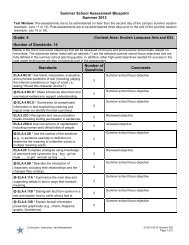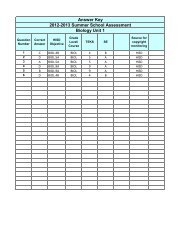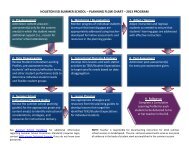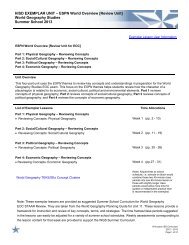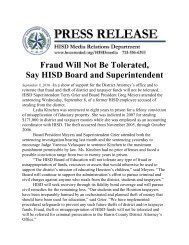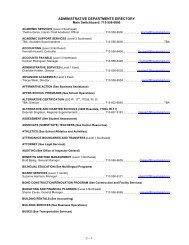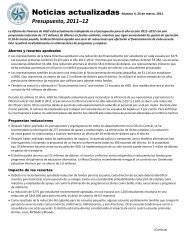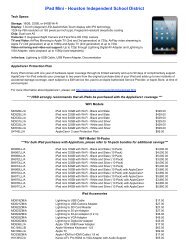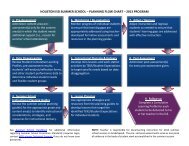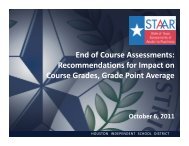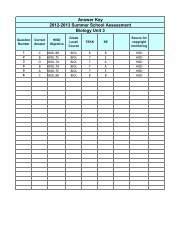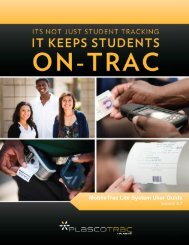Learning Focus
Learning Focus
Learning Focus
You also want an ePaper? Increase the reach of your titles
YUMPU automatically turns print PDFs into web optimized ePapers that Google loves.
HOUSTON ISD SUMMER SCHOOL – PLANNING FLOW CHART – 2013 PROGRAM1. Pre-AssessmentAdminister content-area preassessment(s)only for the contentarea(s) in which the student needsadditional support (i.e., reason forsummer school attendance).6. Monitoring / Re-evaluationMonitor progress of individual studentsto ensure that learning gaps areappropriately addressed using teacherdevelopedformative assessments andresources in the planning guides.7. Adjust / RegroupAdjust instruction and regroupstudents as needed to ensure thatstudents' learning gaps are addressedwith effective instruction.2. Data DisaggregationReview Student Cumulative <strong>Learning</strong>Profiles, pre-assessment results,students' self-analysis/reflection forms,and other student performance data todetermine individual student needsand flexible student groups.5. Instructional Planning & DeliveryDevelop mini-lessons and work stationactivities by TEKS/Student Expectationsto target specific needs based on datadisaggregation.8. Post-AssessmentAdminister post-assessment(s)for every pre-assessment given.3. Summer SchoolInstructional Planning GuidesReview the summer school planningguide(s) for the appropriate grade andcontent area(s) to identify instructionalconsiderations, strategies, andresources for instructional delivery.4. Lesson PlanningUse appropriate strategies andresources from the planning guides todevelop lessons that target theidentified TEKS/Student Expectationsfor individual students.9. Follow-upComplete a Cumulative<strong>Learning</strong> Profile for eachstudent to be delivered to hisor her teacher in the fall.See Summer School Handbook for additional informationregarding Summer School Promotion Standards (requires login;contact HISD eLearn Technical Support if you do not know yourpassword).NOTE: Teacher is responsible for documenting instruction for 2013 summerschool session on GradeSpeed. The pre- and post-assessments serve as one pieceof evidence in the body of student work accomplished in the summer session.
Science Grade 2Summer School Curriculum Planning GuideSummer Session <strong>Learning</strong> <strong>Focus</strong>: The Summer School program is designed to focus on individual student areas of deficiency. Use this document to select Instructional Strategiesto address student needs based on data.Key Concepts• Properties • Mass • MeasurementKey Skills• Using non-standard measurement • Collecting and recording data • Using appropriate toolsTEKS/SETime AssessmentInstructional Considerations Instructional Strategies ResourcesSCI.2.5AClassify matter by physicalproperties, including shape,relative mass, relativetemperature, texture,flexibility, and whethermaterial is a solid or liquid.SCI.2.2CCollect data fromobservations using simpleequipment such as handlenses, primary balances,thermometers, and nonstandardmeasurement tools.SCI.2.4ACollect, record, and compareinformation using tools,including computers, handlenses, rulers, primarybalances, plastic beakers,magnets, collecting nets,notebooks, and safetygoggles; timing devices,including clocks andstopwatches; weatherinstruments such asthermometers, wind vanes,and rain gauges; andmaterials to supportobservations of habitats oforganisms such as terrariumsand aquariumsAllocationTeachers mustplan to addressindividualstudent needsbased on dataaccording tosummer schoolpreassessmentand otherdistrict/campusassessmentsordocumentation.Students in thebilingualprogramshould receive30% of theirinstruction ineach contentarea in English;ie. if scienceinstruction is60 minutesdaily, thestudent shouldreceive 18minutes dailyor 72 minutesweeklyinstruction inEnglish. Thistime is distinctfrom the dailyESL block.ConnectionsFormativeAssessmentMeasurementSpanishVersionAcademic VocabularyMeasurementMassPropertyBalanceSizeHeftingEssential Understandings/Guiding QuestionsThe student understands that mass is a physicalproperty of an object that can be measured innon-standard units.1. What is the mass of an object?2. What tools can be used to measure the massof an object?3. Why is it important to use the same nonstandardunit throughout a measurement?Performance ExpectationAt the end of this learning focus, given a set ofobjects, students will be able to measure themass of objects using primary balances and nonstandardunits that approximate metric units.Background Knowledge for TeacherTell students that mass is a physical property ofan object. It is the amount of material in anobject. Mass and weight are two differentmeasurements. Weight is dependent on the pullof gravity, therefore may be a differentmeasurement on Earth versus the Moon, etc.Although understanding the difference of theconcepts of mass and weight is not developed insecond grade – the use of the proper scientificterm of mass should be used. Students shouldpractice saying that a balance compares mass,or how much material is inside an object.Therefore they use mass when measuring with abalance (see strategies andDaily MeasurementThis concept will require a great deal ofcontinued practice for students to master.Provide experiences in predicting and measuringmass in workstations or centers. Students needdaily measurement practice.Nonlinguistic RepresentationAdd pertinent tools and science vocabulary tothe picture/word wall. Include science definitionwith each word.Primary Balance – tool to compare the massof an object.Pan Balancehttp://www.deltaeducation.com/productdetail.aspx?Collection=N&prodID=2094http://www.ohaus.com/products/view/overview.asp?HKEY=001002005002&Source=2Primer BalanceActivities andTutorial forTeachers:http://www.ohaus.com/input/media/opmanuals/80410-01.pdfAdditionalresources can befound onHoughton-MifflinHarcourt (HMH)HMH LoginInformationWhat is it we want all students to learn?- Literacy Leads the Way Best Practices- English Language Proficiency Standards (ELPS)- Process StandardsR - STAAR Readiness StandardsS - STAAR Supporting Standards© Houston ISD – CurriculumSummer 2013Page 1 of 23
Science Grade 2Summer School Curriculum Planning GuideTEKS/SESCI.2.5AClassify matter by physicalproperties, including shape,relative mass, relativetemperature, texture,flexibility, and whethermaterial is a solid or liquid.SCI.2.2CCollect data fromobservations using simpleequipment such as handlenses, primary balances,thermometers, and nonstandardmeasurement tools.SCI.2.4ACollect, record, and compareinformation using tools,including computers, handlenses, rulers, primarybalances, plastic beakers,magnets, collecting nets,notebooks, and safetygoggles; timing devices,including clocks andstopwatches; weatherinstruments such asthermometers, wind vanes,and rain gauges; andmaterials to supportobservations of habitats oforganisms such as terrariumsand aquariums.TimeAllocation*Follow protocolstated on page 1.AssessmentConnectionsInstructional Considerations Instructional Strategies Resourcesresources for balances).2 nd grade students will not learn about exactmass in grams. They will compare objects todetermine if they are heavier, lighter or equal inmass.Student ActivityStudents will then find the mass of objects usingnon-standard units that approximate metric unitssuch as centimeter cubes or large paper clipswhich have a mass of one gram (see resourcesto purchase centimeter cubes).Divide students into pairs. Give each group ofstudents a primary balance. Discuss as a wholegroup the parts of the system included in thebalance. They will have had some experiencewith a balance in Kindergarten and 1 st grade.Teacher note: Make sure to calibrate eachbalance before giving it to the students.Mass (non-standard units)Remind students of the steps for measuring withnon-standard units of measurement:• Choose an object that is the same size andsame shape.• Use only this object or unit to find themeasurement.• Estimate the measurement• Count and record the units.Model for students how to estimate the mass ofan object by hefting the object. Remind studentsthat to heft an object is to compare the mass ofobjects by placing an object in one hand andpretend to be balance by feeling if the object isheavier, lighter or equal to the second object.Students will then practice finding the mass of anobject using non-standard units of measure suchas centimeter cubes, or large paper clips. Both ofthese non-standard units approximate the metricunit – one gram.• Give students 3 or 4 objects such as a rock, aCD case, a toy car. Have students heft eachobject. After hefting each object have studentspredict which object is heavy and which objectis light and compare the objects.Create a chart to record the mass of an objectusing standard metric units. Display the chart inthe classroom for several weeks.Measuring MassNon-standard units – centimeter cubeObjectEstimationActualMeasurementhttp://www.etacuisenaire.com/catalog/product?deptId=&prodId=4650&q=centimeter+cubesHouston PublicLibrary has theseand other titlesavailable:• MeasuringWeight andTme by AndrewKing• Measuring bySally Hewitt(Take off withseries)• How big is it?: abig book allabout bignessby Ben HillmanWhat is it we want all students to learn?- Literacy Leads the Way Best Practices- English Language Proficiency Standards (ELPS)- Process StandardsR - STAAR Readiness StandardsS - STAAR Supporting Standards© Houston ISD – CurriculumSummer 2013Page 2 of 23
Science Grade 2Summer School Curriculum Planning GuideTEKS/SESCI.2.5AClassify matter by physicalproperties, including shape,relative mass, relativetemperature, texture,flexibility, and whethermaterial is a solid or liquid.TimeAllocation*Followprotocol statedon page 1.AssessmentConnectionsInstructional Considerations Instructional Strategies Resources• Have students test their predictions using nonstandardunits such as centimeter cubes orlarge paperclips and a balance.• Have students record their measurements intheir science notebook using a chart similar tothe one displayed in the instructionalstrategies column.Use the textbook and literature to extend thestudent activity (see resources).SCI.2.2CCollect data fromobservations using simpleequipment such as handlenses, primary balances,thermometers, and nonstandardmeasurement tools.SCI.2.4ACollect, record, and compareinformation using tools,including computers, handlenses, rulers, primarybalances, plastic beakers,magnets, collecting nets,notebooks, and safetygoggles; timing devices,including clocks andstopwatches; weatherinstruments such asthermometers, wind vanes,and rain gauges; andmaterials to supportobservations of habitats oforganisms such as terrariumsand aquariums.What is it we want all students to learn?- Literacy Leads the Way Best Practices- English Language Proficiency Standards (ELPS)- Process StandardsR - STAAR Readiness StandardsS - STAAR Supporting Standards© Houston ISD – CurriculumSummer 2013Page 3 of 23
TEKS/SESCI.2.5AClassify matter by physicalproperties, including shape,relative mass, relativetemperature, texture,flexibility, and whethermaterial is a solid or liquid.TimeAllocation*Follow protocolstated on page 1.AssessmentConnectionsFormativeAssessmentStates ofMatterSpanishVersionScience Grade 2Summer School Curriculum Planning GuideInstructional Considerations Instructional Strategies ResourcesAcademic VocabularyClassifySolidStates of matter LiquidGasEssential Understandings/Guiding QuestionsThe student understands that matter exists inthree states – solids, liquids and gases.1. What are the properties of a solid?2. What are the properties of a liquid?3. What are the properties of a gas?Performance ExpectationAt the end of this learning focus, given variousobjects, the students will be able to classify theobjects as a solid, a liquid or a gas.Background Information for TeacherEverything is made of matter. Matter is anythingthat has mass and takes up space. Matter existsin three states – solids, liquids and gases (seeinstructional strategies).Solids have mass, take up space, are usuallyhard and do not change shape easily but can bereshaped if heat or a force is applied. (A force isa push or a pull.)Liquids have mass, no shape of their own butdo take the shape of their container and flow.Gases take up space, have mass (it is verydifficult to get a precise reading), have nodefinite volume or shape. It is difficult to seegases.Student ActivityStudents will experience one state of matterat a time. Group students into pairs and haveenough materials and supplies for eachgroup. Encourage cooperative learning andgroup discussion through think-pair-share(see strategies)Nonlinguistic RepresentationAdd science vocabulary to the picture/wordwall. Include science definition with each wordincluding solid, liquid and gas.http://www.cofc.edu/~martine/111LectWeek1_files/image008.jpgAdditional lessonsfor States ofMatterhttp://www.lessonplanspage.com/ScienceGasLiquidSolidStudentEnactment38.htmWhat is it we want all students to learn?- Literacy Leads the Way Best Practices- English Language Proficiency Standards (ELPS)- Process StandardsR - STAAR Readiness StandardsS - STAAR Supporting Standards© Houston ISD – CurriculumSummer 2013Page 4 of 23
Science Grade 2Summer School Curriculum Planning GuideTEKS/SESCI.2.5AClassify matter by physicalproperties, including shape,relative mass, relativetemperature, texture,flexibility, and whethermaterial is a solid or liquid.TimeAllocation*Followprotocol statedon page 1.AssessmentConnectionsInstructional Considerations Instructional Strategies Resources<strong>Learning</strong> Centers/Stations - SolidsDisplay objects such as a rock, a toy car, apencil, a ball of clay etc, containers that will holdan individual object, containers full of water,dishpans to hold the containers of water and adouble pan balance with gram stackers.Students will:• Find and record the mass of each object usingnon-standard units.• Place one object at a time inside an emptycontainer.• Observe the container and determine if theobject changed.• Repeat the process with each object.• Fill the container used above with water. Placea dishpan under the water filled container tocatch any spills. Place one object at a timeinside the container full of water to teach theconcept that the solid will take up space.When the solid is placed inside a container ofwater, the water will spill out. The object takesup space and moves the water out of thecontainer.• Ask the following guiding questions:− Did the solid object take up space?− How do you know?Have students record their observations in adata chart and draw and label a picture of the setup in their science notebook (see strategies).<strong>Learning</strong> Center/Station - LiquidsPlace liquids such as water, juice, milk or dishsoap in different size containers. Have othercontainers of various sizes and shapes availablealso.Students will:• Observe the liquids in their original containerand draw the shape.• Pour the liquids into another container anddraw the shape.• Repeat with each container and recordobservations.Cooperative <strong>Learning</strong>Think-Pair-ShareThis strategy allows students time to think and toreceive feedback:• Give each student a minute to think about theirobservations.• Have students pair up for another minute andtell each other their observations.• Randomly call on a few students to sharetheir thoughts with the class.Cues, Questions, and Advanced OrganizersGraphic OrganizersA flexible instructional tool to help studentsconstruct meaning and organize their knowledgebefore, during or after instruction.Observing SolidsDoes theObject Mass object takeup space?RockToy CarPencilDelta ScienceModule (DSM) –PropertiesOrFOSS Solids andLiquids• Contact theScienceMaterialsResourceCenter at 713-726-2219.Teachers musthave attendedtraining beforethey can checkout kits.ProfessionalDevelopmentServices offerskit trainings.brainpop.comStates of matterUnited Streamingwww.unitedstreaming.comThree Types ofMatterHouston PublicLibrary has theseand other titlesavailable:• Solids, Liquids,and Gases byGinger GarrettStudent Activity Cont.Students should observe the liquid taking theshape of the container it is poured into.Have students record their observations and SCI.2.5AClassify matter by physicalproperties, including shape,relative mass, relativetemperature, texture,flexibility, and whetherWhat is it we want all students to learn?*Follow protocolstated on page 1- Literacy Leads the Way Best Practices- English Language Proficiency Standards (ELPS)- Process Standardsdraw and label a picture of the set up in theirscience notebook.R - STAAR Readiness StandardsAdditional activities and lessons are listed in thewebsites in the resources column.S - STAAR Supporting StandardsTwo-Column NotesAn active reading/listening strategy that requiresprocessing information as notes are taken.Using columns, separate main ideas, concepts,© Houston ISD – CurriculumSummer 2013Page 5 of 23enVision MathOnline DigitalSystem Science
Science Grade 2Summer School Curriculum Planning GuideTEKS/SESCI.2.5AClassify matter by physicalproperties, including shape,relative mass, relativetemperature, texture,flexibility, and whethermaterial is a solid or liquid.SCI.2.2CCollect data fromobservations using simpleequipment such as handlenses, primary balances,thermometers, and nonstandardmeasurement tools.SCI.2.4ACollect, record, and compareinformation using tools,including computers, handlenses, rulers , primarybalances, plastic beakers,magnets, collecting nets,notebooks, and safetygoggles; timing devices,including clocks andstopwatches; weatherinstruments such asthermometers, wind vanes,and rain gauges; andmaterials to supportobservations of habitats oforganisms such as terrariumsand aquariums.TimeAllocation*Follow protocolstated on page 1AssessmentConnectionsColdCoolHeatHotWarmInstructional Considerations Instructional Strategies ResourcesAcademic VocabularyTemperatureThermometerFreezingMeltingEssential Understandings/Guiding QuestionsStudents understand that heat causes changesin matter such as melting.1. What science tool is used to measuretemperature?Performance ExpectationAt the end of this learning focus, students will beable to compare the temperature of differentobjects and make a list of changes observed inmaterials caused by heating or cooling.Background Information for TeacherStudents will not read a thermometer in degreesCelsius in 2 nd grade, but merely understand howa thermometer works. They should observe thered liquid in a thermometer going up when it ishot and the red liquid going down when it is cold.The temperature of an object is a physicalproperty of an object. Temperature is how hot orcold something is. Temperature can bemeasured by using our sense of touch and byusing a science tool called a thermometer.Student ActivityShow students a demonstration thermometer(see strategies & resources). Remind studentsthat the thermometer is the tool used to measurehow hot or cold something is. Give each studenta thermometer. Have them draw a picture of thethermometer in their notebook and label its parts.Picture/Word WallAdd science vocabulary to the picture/wordwall including thermometer.ThermometerNon-breakablethermometerhttp://www.etacuisenaire.com/catalog/product?deptId=&prodId=6250&q=thermometersorhttp://www.deltaeducation.com/productdetail.aspx?Collection=N&prodID=3110Studentthermometershttp://www.deltaeducation.com/productsearch.aspx?search=thermometersWhat is it we want all students to learn?- Literacy Leads the Way Best Practices- English Language Proficiency Standards (ELPS)- Process StandardsR - STAAR Readiness StandardsS - STAAR Supporting Standards© Houston ISD – CurriculumSummer 2013Page 6 of 23
Science Grade 2Summer School Curriculum Planning GuideTEKS/SESCI.2.5AClassify matter by physicalproperties, including shape,relative mass, relativetemperature, texture,flexibility, and whethermaterial is a solid or liquid.SCI.2.2CCollect data fromobservations using simpleequipment such as handlenses, primary balances,thermometers, and nonstandardmeasurement tools.SCI.2.4ACollect, record, and compareinformation using tools,including computers, handlenses, rulers , primarybalances, plastic beakers,magnets, collecting nets,notebooks, and safetygoggles; timing devices,including clocks andstopwatches; weatherinstruments such asthermometers, wind vanes,and rain gauges; andmaterials to supportobservations of habitats oforganisms such as terrariumsand aquariums.TimeAllocation*Followprotocol statedon page 1.AssessmentConnectionsInstructional Considerations Instructional Strategies ResourcesGroup the students into pairs. Give each pair ofstudents a thermometer. Have them take theirthermometer outside and place it on the groundin a sunny location for 5-8 minutes. Students willobserve the red liquid in the thermometer andrecord any changes.Instruct students to take their thermometer tovarious places around the school including thecafeteria, the library or the gym. Students willobserve the red liquid in the thermometer andrecord any changes.Give each pair of students one plastic bowlwith hot water (not to exceed 55 degreesCelsius) and one bowl of ice water. Studentswill place their thermometer in the cold waterand observe the red line on a thermometer.Students will place their thermometer in thehot water and observe the red line on athermometer.What is it we want all students to learn?- Literacy Leads the Way Best Practices- English Language Proficiency Standards (ELPS)- Process StandardsR - STAAR Readiness StandardsS - STAAR Supporting Standards© Houston ISD – CurriculumSummer 2013Page 7 of 23
Science Grade 2Summer School Curriculum Planning GuideKey Concepts• Measurement • Metric Units • Length • ForceKey Skills• Predicting movement • Describing movement • Describing change in location • Recording informationHISD ObjectivesTime AssessmentAllocation ConnectionsInstructional Considerations Instructional Strategies ResourcesSCI.2.6CTrace the changes in the positionof an object over time such as acup rolling on the floor and a carrolling down a ramp.SCI.2.4ACollect, record, and compareinformation using tools, includingcomputers, hand lenses, rulers,primary balances, plasticbeakers, magnets, collecting nets,notebooks, and safety goggles;timing devices, including clocksand stopwatches; weatherinstruments such asthermometers, wind vanes, andrain gauges; and materials tosupport observations of habitats oforganisms such as terrariums andaquariums.*Followprotocolstated onpage 1.FormativeAssessmentMovementSpanishVersionPositionMovementAcademic VocabularyPushPullForceEssential Understanding/Guiding QuestionsThe student understands that a force is a push ora pull that will cause a change in motion of anobject.1. What is a push or a pull called?2. What will happen to an object if a force isapplied?Performance ExpectationAt the end of this learning focus, given an objectsuch as a cup or toy car, students will be able totrace changes in position and compare patterns ofmovement.Background Information for TeacherForce is a push or a pull. The interaction of forcescauses movement. Movement is the change inposition of an object. The amount of force tomove an object may be affected by the amount ofmass in an object. The more mass an object hasthe more force it takes to move it to a differentposition. Visit brainpop.com for further teacherinformation on force and motion (see resources).Student ActivityHave students place their pencil on their desk andtry to move it without touching it. Ask the studentsif this was possible. Why or why not?• Ask the students what must happen to thepencil for it to move. Lead them to understandthat a force must be applied to the pencil. Thepencil must be pushed or pulled before it willmove.• Ask students if it is easier to move a smallpencil or a large table. Ask students why theythink it is easier to move a small pencil. Leadthem to understand that the pencil hasScience NotebookingContinue to model for students the classexpectation for Science Notebooking. Includeillustrations and labeling. Use of a sciencenotebook should be consistent throughout theyear in science (see resources).Nonlinguistic RepresentationEncompasses a variety of instructional activitiesincluding developing mental pictures and drawingpictures. Technical Drawing is a nonverbal way ofprocessing information. (R Marzano)Add pictures and words to the word wall.ScienceNotebookingSamples forPrimary AgeStudentswww.sciencenotebooks.orgBrainpop.com (forteacher info)ForceBrainpopjr.comPushes and PullsBBC SchoolScience Clips:http://www.bbc.co.uk/schools/scienceclips/ages/5_6/pushes_pulls_fs.shtmlWhat is it we want all students to learn?- Literacy Leads the Way Best Practices- English Language Proficiency Standards (ELPS)- Process StandardsR - STAAR Readiness StandardsS - STAAR Supporting Standards© Houston ISD – CurriculumSummer 2013Page 8 of 23
Science Grade 2Summer School Curriculum Planning GuideHISD ObjectivesSCI.2.8CExplore the processes in thewater cycle, includingevaporation, condensation, andprecipitation, as connected toweather conditions.TimeAllocation*Followprotocolstated onpage 1.AssessmentConnectionsInstructional Considerations Instructional Strategies ResourcesBackground Teacher InformationOur Earth has a small amount of usable freshwater. Fresh water is recycled. This process iscalled the water cycle. Water is warmed by heatenergy. The major source of heat energy onEarth is the sun. As the water is warmed itchanges from a liquid to a gas. This process iscalled evaporation.Evaporation is a part of the water cycle.This gas is called water vapor. Water vapor iswater in the air that stays in the air until it iscooled. When it is cool enough water vaporchanges back to a liquid. This process is calledcondensation.Precipitation is a part of the water cycle thatoccurs when water vapor cools and forms tinywater droplets. The droplets of water become tooheavy to stay in the air. When this happens thedroplets fall to the ground. The droplets can be inthe form of rain, sleet, snow or hail.Student ActivitiesEvaporationHave students observe the properties of a wetsponge. Ask students to “write” the first letter oftheir name on their desk with the wet sponge.Cooperative <strong>Learning</strong>Think-Pair-ShareThis strategy allows students time to think and toreceive feedback:• Give each student a minute to think about theirobservations.• Have students pair up for another minute andtell each other their observations.• Randomly call on a few students to sharetheir thoughts with the class.• Have students predict what will happen to the“water letter”. Students will make observationsas the water evaporates. Ask students thefollowing questions:1. Where did the water go?2. How long did it take for the water todisappear?3. Do you think we could do something tomake the water disappear faster?• Lead students to understand that the waterevaporated. The water changed from a liquidto a gas called water vapor. Water vapor iswater in the air.Group students into groups of 2-3 to observe thewet sponge again and brainstorm ways toevaporate the water in the sponge. Use theThink-Pair-Share strategy (see instructionalstrategies) for the students to formulate a plan toevaporate the water from the sponge in the leastamount of time.What is it we want all students to learn?- Literacy Leads the Way Best Practices- English Language Proficiency Standards (ELPS)- Process StandardsR - STAAR Readiness StandardsS - STAAR Supporting Standards© Houston ISD – CurriculumSummer 2013Page 12 of 23
Science Grade 2Summer School Curriculum Planning GuideHISD ObjectivesSCI.2.8CExplore the processes in thewater cycle, includingevaporation, condensation, andprecipitation, as connected toweather conditions.SCI.2.4ACollect, record, and compareinformation using tools, includingcomputers ,hand lenses, rulers ,primary balances, plasticbeakers, magnets, collectingnets, notebooks, and safetygoggles; timing devices,including clocks andstopwatches ; weatherinstruments such asthermometers , wind vanes, andrain gauges; and materials tosupport observations of habitatsof organisms such as terrariumsand aquariums.TimeAllocation*Followprotocolstated onpage 1.AssessmentConnectionsInstructional Considerations Instructional Strategies ResourcesSome ways to evaporate the water might be toplace the sponge outside in the hot sunshine,use a hair dryer, place it near the air conditioningvent, put it under a heat lamp, etc.Have student groups record their predictions andplan in their science lab notebook. Instructstudents to test their plan and record theirresults.• Discuss as a whole group in which plan didevaporation occur. Discuss which plansallowed for evaporation to occur in the leastamount of time.As an additional investigation have student place20 mL of water in 3 bowls. Have students placeeach bowl in a different location such as on awindow sill, a table outside and a closet awayfrom direct sunlight. Have students observe eachbowl every day until all of the water isevaporated.• Ask students the following questions againabout this investigation:• Where did the water go?• How long did it take for the water todisappear?• Do you think we could do something tomake the water disappear faster?Allow students to experience evaporation manytimes, discuss and record results in their sciencenotebook. Remind students that evaporation isthe process by which heat energy warms wateruntil it changes from a liquid to a gas calledwater vapor. For more evaporation investigationssee the resources column.Identifying Similarities and DifferencesFrayer ModelThe Frayer Model is a graphic organizer used fordeveloping a student’s vocabulary. Vocabularydevelopment is central to student success inscience and is especially critical for the successof English Language Learners. Students cannotunderstand content-area reading passages ifthey do not know the meaning of key words inthe passage. More than merely defining words,this model requires students to examine both aword’s meaning and its application. Studentsconsider not just what a thing is, but what it isnot. Such exercises build key reasoning skillssuch as determining similarities and differences,comparing, classifying, and creating metaphorsand analogies. Frayer Models can be usedbefore, during or after a lesson.My definitionExamplesWord tobe definedIllustrationNon-ExamplesELL/struggling readers’ modifications: Model andprovide ELL student friendly definition, nativelanguage support, and mixed-ability partners.EvaporationInvestigations:http://aquarius.nasa.gov/pdfs/evap_invest.pdf• Use the Frayer Model as a strategy to connectthe vocabulary for this lesson. Place the word“Evaporation” in the center of the graphicorganizer and as a whole group fill out eachsection of the model. After modeling thisstrategy several time students will be able touse the strategy independently or with apartner (see instructional strategies).CondensationPlace supplies for the condensation investigationon a table (paper cup (not Styrofoam), ice, water,What is it we want all students to learn?- Literacy Leads the Way Best Practices- English Language Proficiency Standards (ELPS)- Process StandardsR - STAAR Readiness StandardsS - STAAR Supporting Standards© Houston ISD – CurriculumSummer 2013Page 13 of 23
Science Grade 2Summer School Curriculum Planning GuideHISD ObjectivesSCI.2.8CExplore the processes in thewater cycle, includingevaporation, condensation, andprecipitation, as connected toweather conditions.SCI.2.4ACollect, record, and compareinformation using tools, includingcomputers ,hand lenses, rulers ,primary balances, plasticbeakers, magnets, collectingnets, notebooks, and safetygoggles; timing devices,including clocks andstopwatches ; weatherinstruments such asthermometers , wind vanes, andrain gauges; and materials tosupport observations of habitatsof organisms such as terrariumsand aquariums.TimeAllocation*Followprotocolstated onpage 1.AssessmentConnectionsInstructional Considerations Instructional Strategies Resourcesand bowl).• Have students observe the supplies andpredict what will be observed or created withthe supplies. Have students record theirpredictions in their science lab notebooks. Seestrategies for sample chart.• Instruct students to fill a paper cup with ice.Place 100 mL of water into the paper cup.Place the paper cup in a bowl and observe thecup and water. Have students draw a pictureof the setup.• Observe the cup again in 15 minutes. Recordwhat is taking place outside the cup and insidethe bowl. Have students draw a picture of theset up again. Ask students the followingquestion:− “How did the water get on the outside ofthe cup?”• Observe the dish again in 30 minutes. Recordobservations in the students’ science notebook(see strategies). Pose the following question tothe students:− “Where is the water that is inside in thebowl coming from?”Have students dry off the outside of the cup.Place 2-3 drops of green food coloring in thewater. Observe the cup of water for 15 minutes.Is the water on the outside of the cup green?• This proves that the water is not leaking fromthe cup. The water vapor in the air collected onthe outside of the cup and has changed from agas to a liquid. This process is calledcondensation and is part of the water cycle.Cues, Questions, and Advanced OrganizersGraphic OrganizersCondensationInvestigationCup with IceIllustration PropertiesCup with Ice and100 mL of waterIllustration PropertiesPicture/Word WallUse of a picture/word wall or other method ofdisplaying science vocabulary will reinforcescience concepts.Example:Condensation on a glass:CondensationInvestigations:http://www.easyscience-fairprojects.net/condensation.htmlhttp://www.kidsscienceexperiments.com/steamingup.htmlHave students observe various forms ofcondensation at home (on their mirror when theytake a shower) and at school (on cold drink cups,windows, etc) and report their findings to theclass. For more investigations see websiteslisted in the resources column.Condensation on a window:What is it we want all students to learn?- Literacy Leads the Way Best Practices- English Language Proficiency Standards (ELPS)- Process StandardsR - STAAR Readiness StandardsS - STAAR Supporting Standards© Houston ISD – CurriculumSummer 2013Page 14 of 23
Science Grade 2Summer School Curriculum Planning GuideHISD ObjectivesSCI.2.8CExplore the processes in thewater cycle, includingevaporation, condensation, andprecipitation, as connected toweather conditions.SCI.2.4ACollect, record, and compareinformation using tools, includingcomputers ,hand lenses, rulers ,primary balances, plasticbeakers, magnets, collectingnets, notebooks, and safetygoggles; timing devices,including clocks andstopwatches ; weatherinstruments such asthermometers , wind vanes, andrain gauges; and materials tosupport observations of habitatsof organisms such as terrariumsand aquariums.TimeAllocation*Followprotocolstated onpage 1.AssessmentConnectionsInstructional Considerations Instructional Strategies ResourcesStudent Activities cont.Show students Evaporation and Condensationfrom United Streaming to reinforce concepts (seeresources). Use a Two Column note takingstrategy to record information (see strategies).PrecipitationRecreate the Condensation Cup setup. Havestudents observe the water droplets as they rolldown the side of the cup. Ask the students topredict what is happening to the water droplets.• Tell the students that the droplets of waterbecome too heavy to stay in the air. When thishappens the droplets fall to the ground. This iscalled precipitation.Have students create an additional precipitationmodel using a transparent cup filled with hotwater (not to exceed 55 °C), plastic wrap forminga tight seal around the top of the cup and icecubes on the top of the plastic wrap.• Students will observe precipitation falling fromthe top of the plastic wrap in about 10 minutes.• Remind students that precipitation is a part ofthe water cycle in which water vapor changesfrom a gas to a liquid.Two-Column NotesAn active reading/listening strategy that requiresprocessing information as notes are taken. Usingcolumns, separate main ideas, concepts, andhigher level thinking questions from thesupporting details. Below is an example of asimple two-column note taking graphic forprimary age students.The Water CycleEvaporationCondensationModels and DiagramsCreate a model of the water cycle.UnitedStreaming:Username andpasswordprovided byLibrary Services• The WaterCycle• Evaporation• CondensationWater cyclemodel:http://www.channel4learning.net/sites/essentials/geography/units/rivers_ah.shtmlComplete water cycle modelAs a class, create a model of the water cycle(see resources for more suggestions). Using aclear plastic shoebox-sized box, put a mound ofsand in one corner, and add a handful of icecubes on top of the mound.• Cover the box tightly with a lid or tape plasticwrap across the top so that the system isclosed. Set the box in a sunny area or under aheat lamp.• Have students predict and record in theirscience lab notebooks what will happen to theice in the box.After one hour have studentsmake observations and describe what isWhat is it we want all students to learn?- Literacy Leads the Way Best Practices- English Language Proficiency Standards (ELPS)- Process StandardsR - STAAR Readiness StandardsS - STAAR Supporting Standards© Houston ISD – CurriculumSummer 2013Page 15 of 23
Science Grade 2Summer School Curriculum Planning GuideHISD ObjectivesSCI.2.8CExplore the processes in thewater cycle, includingevaporation, condensation, andprecipitation, as connected toweather conditions.SCI.2.4ACollect, record, and compareinformation using tools, includingcomputers ,hand lenses, rulers ,primary balances, plasticbeakers, magnets, collectingnets, notebooks, and safetygoggles; timing devices,including clocks andstopwatches ; weatherinstruments such asthermometers , wind vanes, andrain gauges; and materials tosupport observations of habitatsof organisms such as terrariumsand aquariums.TimeAllocation*Followprotocolstated onpage 1.AssessmentConnectionsInstructional Considerations Instructional Strategies Resourceshappening. Have them draw a picture of thesetup and write an explanation of what ishappening in their science notebooks.Create individual water cycle models in Ziplocbags. Tape a Ziploc bag with a small amount ofwater in the corner to a window that receives agreat deal of sunshine (see strategies). Remindstudents that the Earth receives most of its lightand heat energy from the sun.Display diagrams or drawings of the completewater cycle around the classroom after thestudents have experience each processindividually. These experiences will assiststudents in understanding a 2 dimensionaldiagram (see strategies).Explain/discuss with the students that freshwater in lakes and ponds and salt water inoceans are recycled through the water cycle.Use the textbook, videos and literatureconnections to enhance learning (seeresources).Create the water cycle in a Ziploc bag:Models and DiagramsCreate a model of the water cycle.Word Wall forParts of Planthttp://www.brainpopjr.com/science/plants/partsofaplant/wordwall/brainpop.comWater CycleWhat is it we want all students to learn?- Literacy Leads the Way Best Practices- English Language Proficiency Standards (ELPS)- Process StandardsR - STAAR Readiness StandardsS - STAAR Supporting Standards© Houston ISD – CurriculumSummer 2013Page 16 of 23
Science Grade 2Summer School Curriculum Planning GuideKey Concepts• Characteristics of Plants • Basic Needs of Plants • Growth • Environment• Decomposer • Organic Matter • Respiration • ScavengerKey Skills• Measuring• Comparing CharacteristicesHISD ObjectivesTime AssessmentInstructional Considerations Instructional Strategies ResourcesSCI.2.10BObserve, record, and comparehow the physical characteristics ofplants help them meet their basicneeds such as stems carry waterthroughout the plant.SCI.2.2AAsk questions about organisms,objects, and events duringobservations and investigations.Allocation*Followprotocolstated onpage 1.ConnectionsFormativeAssessmentParts of aPlantSpanishVersionPhysical characteristicsGrowthPrecipitationTemperatureInvestigationsAcademic VocabularyStemRootsLeavesFlowersPetalSeedEssential Understandings/Guided QuestionsThe student understands that plants havephysical characteristics that help them to meettheir basic needs.1. What are the basic needs of a plant?2. What is the function of a stem? Root? Leaf?Flower?3. How does temperature affect growth of aplant?4. What will happen if a plant gets too muchprecipitation? Not enough precipitation?Performance ExpectationAt the end of this learning focus, given a diagramof a plant, students will be able to identify or labelits basic parts.Background Information for TeacherContinue to add words to the science pictureword wall (see strategies and resources).Living things are called organisms. Livingorganisms have basic needs. These needs arefood, water, air, and space to live and grow.Background Information for Teacher cont.Living organisms are called organisms. Livingthings have basic needs. These needs are food,water, air, and space to live and grow. Livingorganisms reproduce or have young/offspring.Plants are living organisms that have parts thathelp it meet its basic needs.Word and Picture WallsContinue implement the use of a word andpicture wall to reinforce vocabulary acquisition.Add all words that describe plant parts and theirfunction (see resources).Plant parts andfunctionhttp://www.mbgnet.net/bioplants/parts.htmlHelping PlantsGrow WellInteractive activityon plant growthhttp://www.bbc.co.uk/schools/scienceclips/ages/7_8/science_7_8.shtmlHouston PublicLibrary• The ABCs ofPlants byBobbie Kalman• The Plant Cycleby Nina MorganWhat is it we want all students to learn?- Literacy Leads the Way Best Practices- English Language Proficiency Standards (ELPS)- Process StandardsR - STAAR Readiness StandardsS - STAAR Supporting Standards© Houston ISD – CurriculumSummer 2013Page 17 of 23
Science Grade 2Summer School Curriculum Planning GuideHISD ObjectivesSCI.2.10BObserve, record, and comparehow the physical characteristics ofplants help them meet their basicneeds such as stems carry waterthroughout the plant.SCI.2.2AAsk questions about organisms,objects, and events duringobservations and investigations.TimeAllocation*Followprotocolstated onpage 1.AssessmentConnectionsInstructional Considerations Instructional Strategies ResourcesRoots are a part of the plant that grows underthe ground. The root takes in water and mineralsthat the plant needs.The stem is a part of the plant that holds up orsupports the plant.Leaves are a part of the plant that grows fromthe stem. Leaves absorb sunlight and makesfood for the plant.Flowers are the reproductive organs of the plant.The flower produces seeds and the petals of aflower attract insects.Most plants reproduce by making seeds. A seedis a young plant with a food supply inside aprotective seed coat.Student ActivityDisplay several full grown plants, such as amarigold or mum, milkweed, etc. Have studentsdraw a picture of the plant in their sciencenotebook. Have students list all the basic needsof a plant including water, nutrients, sunlight, airand space to grow.With a partner have students brainstorm theanswers to the following questions:• What do you think is the function or job of eachpart of the plant?• Create a class chart that defines the functionof each plant part. Display the chart in theclassroom (see strategies and resources).As a whole group discuss the followingquestions. Have students record their responsesin their science notebooks.• What do you observe about the plant?• Is the plant a living organism?What are the basic needs of the plant?Divide students into groups of 2-3. Place severaldifferent types of seeds on a tray (corn, pintobean, lima bean, marigold, sunflower, rye grass,etc.) Give each group of students 3-4 seeds.Cues, Questions, and Advanced OrganizersGraphic OrganizersPlant PartRootStemLeavesFlowerSeedFunction(what it does)Takes in water andminerals from the soilSupports the plantAbsorbs or takes insunlightMakes food for the plantAttracts insects topollinate the plantMakes more plantsenVision MathOnline DigitalSystem ScienceLeveled Readers• All About Plants• Plants• Desert PlantsUnited StreamingVideoParts of a PlantThree Main Partsof a PlantPlants: A FirstLookPlant Life Cyclehttp://www.brainpopjr.com/science/plants/plantlifecycle/FOSS kit NewPlants -May be used toenhance learning.It can bepurchased athttp://www.deltaeducation.com/productdetail.aspx?Collection=Y&prodID=1076&menuID=3AIMS Activities –Primarily PlantsGrades K-3http://store.aimsedu.org/aims_store/books/primarilyplants.htmlHave students observe the seeds with a handlens and draw a picture of the seeds andWhat is it we want all students to learn?- Literacy Leads the Way Best Practices- English Language Proficiency Standards (ELPS)- Process StandardsR - STAAR Readiness StandardsS - STAAR Supporting Standards© Houston ISD – CurriculumSummer 2013Page 18 of 23
Science Grade 2Summer School Curriculum Planning GuideHISD ObjectivesSCI.2.10BObserve, record, and comparehow the physical characteristicsof plants help them meet theirbasic needs such as stems carrywater throughout the plant.SCI.2.2AAsk questions about organisms,objects, and events duringobservations and investigations.TimeAllocation*Followprotocolstated onpage 1.AssessmentConnectionsFormativeAssessmentAnimalsSpanishVersionInstructional Considerations Instructional Strategies Resourcesdescribe their properties in their sciencenotebook.• Instruct students to gather materials andsupplies to plant the seeds (plastic cup, pottingsoil, gravel for bottom of container, measuringcups, water, newsprint to cover table, goggles,lab coats, gloves, etc)• Have students chose a seed. Encouragedifferent students to plant different seeds.• Label the containers according to which typeof seed is planted, place the student’s nameon this label. This will allow students toobserve growth of various kinds of plants.Model how to plant the seeds, then havestudents plant their own in a clear cup.Encourage students to place the seeds aroundthe sides of the cup so they can observe theroots as they begin to grow.AIMS Activities –CrittersGrades K-6http://store.aimsedu.org/aims_store/books/critters.htmlUse the two column notes strategy to view theUnited Streaming video Parts of a Plant orPlants: A First Look.. Have students list the plantparts and their function (see resources andstrategies).Use the FOSS kit – New Plants to investigateother plant parts in detail and to enhancelearning (see resources).For more simple investigations using seeds andplants use Primarily Plants – AIMS Activities (seeresources).What is it we want all students to learn?- Literacy Leads the Way Best Practices- English Language Proficiency Standards (ELPS)- Process StandardsR - STAAR Readiness StandardsS - STAAR Supporting Standards© Houston ISD – CurriculumSummer 2013Page 19 of 23
Science Grade 2Summer School Curriculum Planning GuideHISD ObjectivesSCI.2.10AObserve, record, and comparehow the physical characteristicsand behaviors of animals helpthem meet their basic needs suchas fins help fish move andbalance in the water.SCI.2.2AAsk questions about organisms,objects, and events duringobservations and investigations.TimeAllocation*Followprotocolstated onpage 1.AssessmentConnectionsBehaviorAnimalsInstructional Considerations Instructional Strategies ResourcesAcademic VocabularyHibernationHabitatEssential Understandings/Guided QuestionsThe student understands that animals havephysical characteristics and behaviors that helpthem to meet their basic needs.1. What are the basic needs of an animal?2. What body part helps a fish move?3. What behavior does a pill bug have thatprotects it from enemies?Isopods may bepurchasedthroughCarolinaBiologicalhttp://www.carolina.com/product/terrestrial+isopods+pill+sow+living+bugs+varying+species.do?keyword=isopods&sortby=bestMatchesPerformance ExpectationAt the end of this learning focus, given a diagramof an animal, students will be able to identify thephysical characteristics and behaviors that help itto meet its basic needs.Background Information for TeacherAnimals are living organisms with basic needs.Animals need food, water, air, and space to liveand grow. They reproduce or haveyoung/offspring. Animals have characteristicsthat provide it with the ability to grow anddevelop, to protect itself, and reproduce. Animalshave behaviors that protect them. They maymigrate, hibernate or go into a dormant state iftemperatures decrease or increase.Choose at least two different animals forclassroom observation. Some suggested animalsinclude pill bugs (isopods), earthworms, crickets,or ladybugs. More background information andactivities may be found in AIMS Activities Critters(see resources).Crickets can bepurchased at mostany pet store.Earthworms canby purchased atAcademy andGander Mountain,They can also bedug up from abackyard garden.Ladybugs are soldat most nurseries,usually in earlySpring.General link onorganism carefrom FOSS:http://www.lawrencehallofscience.org/foss/fossweb/teachers/materials/plantanimal.htmlWhat is it we want all students to learn?- Literacy Leads the Way Best Practices- English Language Proficiency Standards (ELPS)- Process StandardsR - STAAR Readiness StandardsS - STAAR Supporting Standards© Houston ISD – CurriculumSummer 2013Page 20 of 23
Science Grade 2Summer School Curriculum Planning GuideHISD ObjectivesSCI.2.10AObserve, record, and comparehow the physical characteristicsand behaviors of animals helpthem meet their basic needs suchas fins help fish move andbalance in the water.TimeAllocation*Followprotocolstated onpage 1.AssessmentConnectionsInstructional Considerations Instructional Strategies ResourcesAllow students to observe and investigate atleast two animals. The procedure will be similarfor each animal. Take at least two lessons tostudy each animal. One day for the initialobservations and the second day to focus on theanimals’ physical characteristics and behaviorsthat helps them to meet their needs.Create a HabitatEarthworm HabitatHollingsworthScience CenterLiving SpecimenRequisition Form(Elementary)SCI.2.2AAsk questions about organisms,objects, and events duringobservations and investigations.Earthworms live underground and maketunnels that loosen the soil. Earthworms eatdecayed leaves and plant material. Theyexcrete these materials through their wasteand add nutrients to the soil.Create a habitat for earthworms by placingthem in a dark plastic container filled withpotting soil. Keep the soil moist. Add deadleaves, grass clippings, fruit and vegetablepeelings to the soil as needed for food. Do notfeed them too much or the food will spoil (seestrategies).Create a habitat for the isopods (pill bugs andsow bugs). Earthworms and isopods live inthe same kind of environment and eat thesame foods. They must be kept moistbecause they breathe through gill likestructures. Place several sticks or logs in thehabitat to give the isopods some place tohide.Student ActivityInitial ObservationsUse the OWL strategy to organize information(see strategies). Carefully place an earthwormon a moist paper towel on each student’s desk.Gently mist it with a spray bottle to keep if moist.• Earthworms and isopods (Pill Bugs) breathethrough gill-like structures and must be keptmoist (see websites in the resource sectionfor more information on earthworms andisopods).Have students observe the earthworm and fill inthe “Observe” section, answering the question“What do I observe?” Have students use a handlens. Students will draw a picture of theearthworm and record their observations in theirscience notebook.What is it we want all students to learn?- Literacy Leads the Way Best Practices- English Language Proficiency Standards (ELPS)- Process StandardsR - STAAR Readiness StandardsS - STAAR Supporting Standards© Houston ISD – CurriculumSummer 2013Page 21 of 23
Science Grade 2Summer School Curriculum Planning GuideHISD ObjectivesSCI.2.10AObserve, record, and comparehow the physical characteristicsand behaviors of animals helpthem meet their basic needs suchas fins help fish move andbalance in the water.SCI.2.2AAsk questions about organisms,objects, and events duringobservations and investigations.TimeAllocation*Followprotocolstated onpage 1.AssessmentConnectionsInstructional Considerations Instructional Strategies ResourcesAsk students to generate a list of informationthey would like to find out or “Wonder” about theanimal. Add this to the OWL chartAsk the following guiding questions to generatediscussion:• What are the physical characteristics of theearthworm? What does it look like?• What do they eat?• How do they move?Bring students together in a large group withtheir notebooks to share their observations.Follow the same steps to observe an isopod (pillbug or sow bug).Physical Characteristics and Behaviors ofEarthworms and IsopodsOn the second day, before you redistribute theanimals. Discuss the physical characteristics ofeach animal and how these characteristicsprotect it from predators and help it meet itsbasic needs.Use the Think-Pair-Share strategy (seestrategies). Have students think about theanswers to the questions independently. Thenhave students turn to their partner and sharewhat they think. After the students have finishedsharing their observations have them record theinformation in their science notebooks.Summarizing and Note-TakingKWLOWL ChartOrganize your chart for inquiry and observation.(What I observe – What I wonder – What Ilearned)EarthwormObserve Wonder LearnedenVision MathOnline DigitalSystem ScienceLeveled Readers• All AboutAnimals• Animal Groups• NocturnalAnimalsCooperative <strong>Learning</strong>Think-Pair-ShareThis strategy allows students time to think and toreceive feedback:• Give each student a minute to think about theirobservations.• Have students pair up for another minute andtell each other their observations.• Randomly call on a few students to sharetheir thoughts with the class.Cues, Questions, and Advanced OrganizersGraphic OrganizersHave students observe and compare thephysical characteristics and behaviors of twodifferent types of isopods (pill bugs and sowbugs). Create a class list (see strategies).Physical Characteristics of an IsopodTell students that both earthworms and isopodshave several behaviors that protect them frompredators. Inform students that the animals alsohave behaviors that protect them from extremetemperature changes. Both animals will burrowdeeper into the ground and hibernate or go into adeep sleep to conserve energy and wait until thetemperatures change.Pill BugsSow BugsWhat is it we want all students to learn?- Literacy Leads the Way Best Practices- English Language Proficiency Standards (ELPS)- Process StandardsR - STAAR Readiness StandardsS - STAAR Supporting Standards© Houston ISD – CurriculumSummer 2013Page 22 of 23
Science Grade 2Summer School Curriculum Planning GuideHISD ObjectivesSCI.2.10AObserve, record, and comparehow the physical characteristicsand behaviors of animals helpthem meet their basic needs suchas fins help fish move andbalance in the water.TimeAllocation*Followprotocolstated onpage 1.AssessmentConnectionsInstructional Considerations Instructional Strategies Resources• As a culminating activity, make a class book inwhich every student contributes a page. Eachstudent chooses one animal, draws it and thenwrites two sentences about how its physicalcharacteristics helps it to meet its basic needs(see strategies).Cues, Questions, and Advanced OrganizersGraphic OrganizersPhysical Characteristics of a FishSCI.2.2AAsk questions about organisms,objects, and events duringobservations and investigations.1. Fish move using fins2. Fish breathe with gills3. Fish have two eyes4. Fish are covered with scalesClass Big BookBook Page ExampleThe cricket has long back legs. This helps itjump high and hop away from an animal thatcan eat it.What is it we want all students to learn?- Literacy Leads the Way Best Practices- English Language Proficiency Standards (ELPS)- Process StandardsR - STAAR Readiness StandardsS - STAAR Supporting Standards© Houston ISD – CurriculumSummer 2013Page 23 of 23




